Telescope Reviews
Page 16
By Ed Ting
Updated 5/21/02
Click on a Telescope Below:
1) Astro-Physics 10" Maksutov
2) Stellarvue 80 mm f/9 Refractor
1) Astro-Physics 10" Maksutov 4/13/01
(10" f/ 14.6 Maksutov-Cassegrain, OTA, case only, $9800)
Life, it is said, is what happens to you while you're busy making other plans. Tell
that to AP owner Roland Christen, who started this Maksutov project years ago. I
first saw Christen's prototypes of the 8" and 10" Mak-Cass scopes at Astrofest in
1999. The views through the prototypes were very encouraging, to say the
least. At that time, AP tentatively took orders for a few units, with expected
delivery sometime in early to mid 2000.
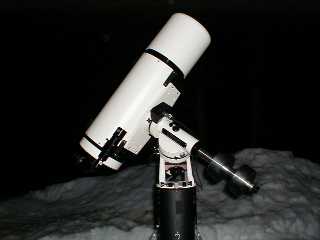 The Big Mak in Action
(Mount: AP900)
Christen's goal may have been to simply polish off a few of these while working on
his other projects, but it wasn't so simple. Astrofest 2000 came and went, with little
sign of the Maks. There were reported problems with coatings, and the figure of
the mirrors was said to be less than what AP wanted for such an expensive product.
The original goal was to produce 20-24 units, but by the end of 2000 scarcely half
that number had actually shipped.
This point illustrates the differences in philosophy between a small, quality-oriented
company like Astro-Physics, and a larger one which might have more bottom-line
pressures. Rather than ship out a merely excellent product, AP elected to wait
until they were absolutely sure the scopes were to Christen's satisfaction. This
philosophy results in the now-famous, years-long waiting lists for their telescopes.
But there is a silver lining to all of this - you can go to bed at night knowing that
when your AP scope does eventually arrive (the owner of this one waited 2 1/2
years), it will be perfect. I have never talked to an unhappy Astro-Physics customer.
In my all-too-brief conversations with Christen on these Maksutovs, I could
sense some hesitancy, and an element of frustration on his part. This turned out
to be a much larger and ambitious project than anyone had forseen. What started
out as just another AP telescope design turned into an all out assault on the
optical state-of-the-art.
I asked Roland about the design of these Maksutov-Cassegrains, and he suggested
they were perhaps most similar to a Gregorian-Maksutov. "But..." he said, after
a few moments of thought, "...not really." He suggested a new term, "Valery-Mak"
after the owner of Aries Instruments, where the mirrors were sourced. But with
all due respect to Valery, it seems that AP had to do enough refiguring and re-
design of their own that we might now have a completely new telescope configuration.
The Big Mak in Action
(Mount: AP900)
Christen's goal may have been to simply polish off a few of these while working on
his other projects, but it wasn't so simple. Astrofest 2000 came and went, with little
sign of the Maks. There were reported problems with coatings, and the figure of
the mirrors was said to be less than what AP wanted for such an expensive product.
The original goal was to produce 20-24 units, but by the end of 2000 scarcely half
that number had actually shipped.
This point illustrates the differences in philosophy between a small, quality-oriented
company like Astro-Physics, and a larger one which might have more bottom-line
pressures. Rather than ship out a merely excellent product, AP elected to wait
until they were absolutely sure the scopes were to Christen's satisfaction. This
philosophy results in the now-famous, years-long waiting lists for their telescopes.
But there is a silver lining to all of this - you can go to bed at night knowing that
when your AP scope does eventually arrive (the owner of this one waited 2 1/2
years), it will be perfect. I have never talked to an unhappy Astro-Physics customer.
In my all-too-brief conversations with Christen on these Maksutovs, I could
sense some hesitancy, and an element of frustration on his part. This turned out
to be a much larger and ambitious project than anyone had forseen. What started
out as just another AP telescope design turned into an all out assault on the
optical state-of-the-art.
I asked Roland about the design of these Maksutov-Cassegrains, and he suggested
they were perhaps most similar to a Gregorian-Maksutov. "But..." he said, after
a few moments of thought, "...not really." He suggested a new term, "Valery-Mak"
after the owner of Aries Instruments, where the mirrors were sourced. But with
all due respect to Valery, it seems that AP had to do enough refiguring and re-
design of their own that we might now have a completely new telescope configuration.
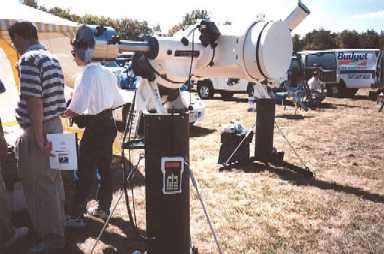 The 10" prototype seen at
Astrofest, 1999
So this Rol-Mak, Christ-Mak, whatever you want to call it, is now in very limited
production, and a few of them have found their way into amateur's hands. I was
most fortunate to have the use of one for a couple of months.
The scope's primary is fused quartz and the corrector is BK-7. The mirror is tapered
at its edges for faster cool-down. The secondary is an aluminized spot on the back
of the corrector plate and is a tiny 2.3 inches (23% central obstruction.) There's
an alternate secondary baffle supplied which actually increases the obstruction
percentage, which is said to be of help during unsteady seeing conditions. While I
had some unsteady skies, I couldn't bring myself handicap the scope in this manner
and the alternate baffle stayed in its box.
The machining of the metal parts is first-rate, as you would expect. The dew shield
fits so tightly that I never even needed to use the set screw. The mirror cell is said
to be turned and milled down from a 30 lb slab of metal. The end result is a cell
weighing a mere 2 lbs (the other 28 lbs is recycled.)
The 10" prototype seen at
Astrofest, 1999
So this Rol-Mak, Christ-Mak, whatever you want to call it, is now in very limited
production, and a few of them have found their way into amateur's hands. I was
most fortunate to have the use of one for a couple of months.
The scope's primary is fused quartz and the corrector is BK-7. The mirror is tapered
at its edges for faster cool-down. The secondary is an aluminized spot on the back
of the corrector plate and is a tiny 2.3 inches (23% central obstruction.) There's
an alternate secondary baffle supplied which actually increases the obstruction
percentage, which is said to be of help during unsteady seeing conditions. While I
had some unsteady skies, I couldn't bring myself handicap the scope in this manner
and the alternate baffle stayed in its box.
The machining of the metal parts is first-rate, as you would expect. The dew shield
fits so tightly that I never even needed to use the set screw. The mirror cell is said
to be turned and milled down from a 30 lb slab of metal. The end result is a cell
weighing a mere 2 lbs (the other 28 lbs is recycled.)
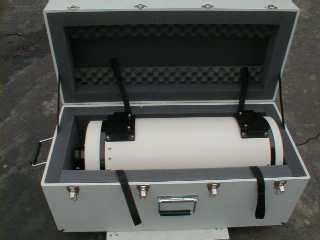 The scope in its case
The scope arrives in a large trunk. It's surprisingly light (33 lbs) and compact,
given its aperture and long 146 inch focal length. Two large straps help you
muscle the OTA out of the case. You can mount this yourself, but it's best to
have help. The Mak is designed to be used with an AP900 or AP1200 mount -
there are aluminum blocks attached to the scope with small allen-head screws
that mate up to the AP900/AP1200 flat plate. I used mostly the AP900 mount,
but for high power observing I dragged out an AP1200 on a couple of nights
with the help of friends.
Mounting the OTA is a bit of a hassle in the dark. Those four allen heads never
seem to want to find their corresponding holes on the plate, and it's all too easy
to back the screws out entirely. When you hear that little "clink" of the screw
hitting your driveway, you sigh and start over. We did eventually modify the scope
to be used on Losmandy's Universal Dovetail Plate, which has a few quirks of its
own but is much easier in the long run. I recommend this arrangement.
The scope in its case
The scope arrives in a large trunk. It's surprisingly light (33 lbs) and compact,
given its aperture and long 146 inch focal length. Two large straps help you
muscle the OTA out of the case. You can mount this yourself, but it's best to
have help. The Mak is designed to be used with an AP900 or AP1200 mount -
there are aluminum blocks attached to the scope with small allen-head screws
that mate up to the AP900/AP1200 flat plate. I used mostly the AP900 mount,
but for high power observing I dragged out an AP1200 on a couple of nights
with the help of friends.
Mounting the OTA is a bit of a hassle in the dark. Those four allen heads never
seem to want to find their corresponding holes on the plate, and it's all too easy
to back the screws out entirely. When you hear that little "clink" of the screw
hitting your driveway, you sigh and start over. We did eventually modify the scope
to be used on Losmandy's Universal Dovetail Plate, which has a few quirks of its
own but is much easier in the long run. I recommend this arrangement.
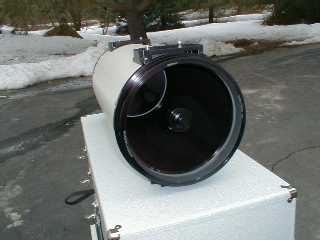 The flash went off in this photo. Note
the complete absence of reflections
off the meniscus lens.
Once mounted, you can breathe easier. What at first looks like a plain, fat, white
tube is actually a sophisticated instrument packed with innovation. The coatings
on the meniscus lens are simply wonderful. It looks practically invisible when
you shine a flashlight into it in the dark; the secondary assembly looks as if
it's floating in the air, and you feel as if you could just reach in and touch the
main mirror.
There are no collimation adjustments at all, which is just fine by me, especially
since this one seems very well aligned out of the box. The focuser is a neat,
and extremely smooth, belt-drive unit that moves the main mirror so precisely
there's little or no image shift, even at 600X. A large shield fits snugly onto
the front of the OTA, acting as an additional light baffle and a dew shield.
There are multiple spots laid out for you to mount finders, and you will need
them. Figure on at least two, and preferably three, so that one is always
within easy reach.
One big bugaboo of Maksutovs is their long cool-down time. There are two large
chunks of glass inherent in this design, and a large column of trapped air in
between them. To combat this, the entire back of the telescope is removable.
You loosen three screws, give the back a twist, and off it comes. What remains
looks like a skeleton. What's even more neat, there are two small pancake-style
fans that help hasten cooling. There's a little jack on the back of the scope
that takes AP's standard 12V connector. People seeing you remove the back of
the scope for the first time sometimes get alarmed. It doesn't look right. But
AP actually encourages you to do this, and you could actually observe with the
back off, if you wanted to.
The flash went off in this photo. Note
the complete absence of reflections
off the meniscus lens.
Once mounted, you can breathe easier. What at first looks like a plain, fat, white
tube is actually a sophisticated instrument packed with innovation. The coatings
on the meniscus lens are simply wonderful. It looks practically invisible when
you shine a flashlight into it in the dark; the secondary assembly looks as if
it's floating in the air, and you feel as if you could just reach in and touch the
main mirror.
There are no collimation adjustments at all, which is just fine by me, especially
since this one seems very well aligned out of the box. The focuser is a neat,
and extremely smooth, belt-drive unit that moves the main mirror so precisely
there's little or no image shift, even at 600X. A large shield fits snugly onto
the front of the OTA, acting as an additional light baffle and a dew shield.
There are multiple spots laid out for you to mount finders, and you will need
them. Figure on at least two, and preferably three, so that one is always
within easy reach.
One big bugaboo of Maksutovs is their long cool-down time. There are two large
chunks of glass inherent in this design, and a large column of trapped air in
between them. To combat this, the entire back of the telescope is removable.
You loosen three screws, give the back a twist, and off it comes. What remains
looks like a skeleton. What's even more neat, there are two small pancake-style
fans that help hasten cooling. There's a little jack on the back of the scope
that takes AP's standard 12V connector. People seeing you remove the back of
the scope for the first time sometimes get alarmed. It doesn't look right. But
AP actually encourages you to do this, and you could actually observe with the
back off, if you wanted to.
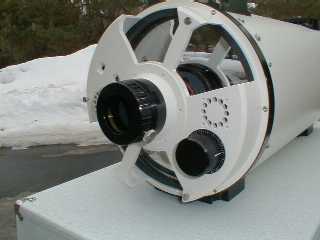 Cool, huh? The Mak with its back
removed. Focuser is at lower right.
I am just enough of a geek that I like taking the back off and watching the
belt drive on the focuser doing its thing. The focuser, by the way, is a multi-
turn type, and you find yourself spinning it a lot to reach focus with differing
styles of eyepieces. Some of us liked this, some of us didn't.
On the first night with this scope, the temperature hovered around 0 degrees F,
which is quite cold even for these parts. The scope seemed to have difficulty
reaching equilibrium. Furthermore, when the OTA finally cooled down, so had
we, and no one was in the mood for extensive testing.
Being the enthusiastic dolt that I am, I tried to run some quick tests. Did I
mention it was cold? It was so cold enough that inside of my nose had frozen;
it hurt to breathe. And breathe I did, right through my scarf and onto the
eyepiece, which promptly fogged up. I tried to look through the eyepiece
anyway, only to touch the side of my nose to the cold, frost-covered 22 mm
Nagler. The skin bonded instantly. Yeow!!! We decided to call it a night.
Several weeks later, temperatures had risen to more reasonable levels, and we
tried again. I set up a multi-evening event at my place, where local amateur
astronomers were free to drop by, have a look, and offer some comments.
The Mak was set up on the AP900, and I wasted no time in throwing everything
I had at it - the AP155, the Takahashi FCT150, and the 10" and 11" EL
Starmasters.
The telescope has an excellent star test, with only slight undercorrection
at high power. Collimation is excellent also, and the contrast is absolutely
superb. Planetary detail is stunning given good conditions. In steady seeing,
it beat everything else in the driveway on Jupiter and Saturn.
It's a good sign when I can't wait to get the formal review stuff out of the
way. Using this criteria, the Mak is a great telescope. I completely lost
interest in reviewing it after the first half hour or so. I searched my memory
for objects in the late winter sky until my mind went dry. Then I grabbed my
Sky Atlas 2000 and started looking for obscure stuff.
I ran some comparisons with the other telescopes. The Starmaster 10" EL
matched the Mak on deep sky, but the Dob won't track at high powers like the
Mak will, and the Mak is slightly better on planets. The AP155 and FCT150
were steadier more of the time on the planets due to their smaller apertures,
but in times of good seeing the Mak put 'em away on low level detail. On
deep sky the Mak beat the refractors all the time. The telescope has superb
contrast. Even the dimmest low contrast galaxies in and around the bowl of
the Big Dipper stood out from the black of the sky.
Cool, huh? The Mak with its back
removed. Focuser is at lower right.
I am just enough of a geek that I like taking the back off and watching the
belt drive on the focuser doing its thing. The focuser, by the way, is a multi-
turn type, and you find yourself spinning it a lot to reach focus with differing
styles of eyepieces. Some of us liked this, some of us didn't.
On the first night with this scope, the temperature hovered around 0 degrees F,
which is quite cold even for these parts. The scope seemed to have difficulty
reaching equilibrium. Furthermore, when the OTA finally cooled down, so had
we, and no one was in the mood for extensive testing.
Being the enthusiastic dolt that I am, I tried to run some quick tests. Did I
mention it was cold? It was so cold enough that inside of my nose had frozen;
it hurt to breathe. And breathe I did, right through my scarf and onto the
eyepiece, which promptly fogged up. I tried to look through the eyepiece
anyway, only to touch the side of my nose to the cold, frost-covered 22 mm
Nagler. The skin bonded instantly. Yeow!!! We decided to call it a night.
Several weeks later, temperatures had risen to more reasonable levels, and we
tried again. I set up a multi-evening event at my place, where local amateur
astronomers were free to drop by, have a look, and offer some comments.
The Mak was set up on the AP900, and I wasted no time in throwing everything
I had at it - the AP155, the Takahashi FCT150, and the 10" and 11" EL
Starmasters.
The telescope has an excellent star test, with only slight undercorrection
at high power. Collimation is excellent also, and the contrast is absolutely
superb. Planetary detail is stunning given good conditions. In steady seeing,
it beat everything else in the driveway on Jupiter and Saturn.
It's a good sign when I can't wait to get the formal review stuff out of the
way. Using this criteria, the Mak is a great telescope. I completely lost
interest in reviewing it after the first half hour or so. I searched my memory
for objects in the late winter sky until my mind went dry. Then I grabbed my
Sky Atlas 2000 and started looking for obscure stuff.
I ran some comparisons with the other telescopes. The Starmaster 10" EL
matched the Mak on deep sky, but the Dob won't track at high powers like the
Mak will, and the Mak is slightly better on planets. The AP155 and FCT150
were steadier more of the time on the planets due to their smaller apertures,
but in times of good seeing the Mak put 'em away on low level detail. On
deep sky the Mak beat the refractors all the time. The telescope has superb
contrast. Even the dimmest low contrast galaxies in and around the bowl of
the Big Dipper stood out from the black of the sky.
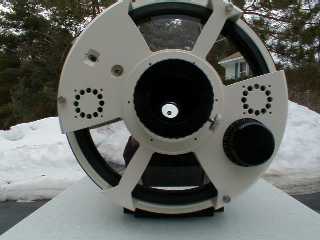 Looking into the visual back with
the cover removed. Power switch
and plug for fans are at 10 o'clock.
Perforated holes mark locations
of the cooling fans.
One side effect of a telescope with a 3708 mm focal length is that you are
kind of boxed in to medium-high to high powers. So you can forget about
looking at the Pleiades and other large extended objects. It felt strange
using using 35 mm and 27 mm Panoptics as planetary eyepieces. The big
Mak is perfect, however, for globulars, double stars, most open clusters, and
especially planets. This high power/narrow FOV issue isn't much of an issue
with me, but for balance I should state that a couple of observers felt closed-in,
even claustrophobic, due to the scope's narrow FOV. As a result, they never
really felt comfortable with it, and one person didn't like the scope at all
because of this.
However, the buyer of one of these will almost certainly have other telescopes
that can do the low power/wide FOV thing. I set up the Mak next to the AP155
and the two were a perfect compliment to one another. In fact, as the weeks
went on, I found myself actually liking the scope's narrow field of view. I used
it to help hone my finding skills and never even bothered to initialize the Goto
systems on either the AP900 or the AP1200.
The Mak will reach focus with the AP/Baader binoviewer. You'll be twisting
the focus knob a lot to move the mirror into place, but it's worth it. Using
a pair of 32 mm Plossls, it's a real shocker on planets. One night I was
in the garage looking over some charts and I heard a shout from outside.
I thought someone might have gotten hurt in the dark. It turns out a club
member had found his way to the Mak and was looking at a shadow transit
on Jupiter (Click here to hear MP3 audio of someone looking through the
binoviewer.) I used the same combination on Saturn and almost fell off my
observing chair.
Clavius on the moon stood out in sharp relief, with little pieces of the moun-
tiantops seemingly hanging out in space in 3D. The Black Eye (M64) seemed
to hang out there in space in front of a backdrop of pinpoint-sharp stars. The
black eye itself looks like a comma-shaped area erased from the galaxy. Hunt-
ing for obscure planetaries is easy with this scope - you just look around until
you find the object in the field that isn't sharp. It is rare that I see a telescope
sharp enough to do this even at relatively modest (100X-110X) powers.
Looking into the visual back with
the cover removed. Power switch
and plug for fans are at 10 o'clock.
Perforated holes mark locations
of the cooling fans.
One side effect of a telescope with a 3708 mm focal length is that you are
kind of boxed in to medium-high to high powers. So you can forget about
looking at the Pleiades and other large extended objects. It felt strange
using using 35 mm and 27 mm Panoptics as planetary eyepieces. The big
Mak is perfect, however, for globulars, double stars, most open clusters, and
especially planets. This high power/narrow FOV issue isn't much of an issue
with me, but for balance I should state that a couple of observers felt closed-in,
even claustrophobic, due to the scope's narrow FOV. As a result, they never
really felt comfortable with it, and one person didn't like the scope at all
because of this.
However, the buyer of one of these will almost certainly have other telescopes
that can do the low power/wide FOV thing. I set up the Mak next to the AP155
and the two were a perfect compliment to one another. In fact, as the weeks
went on, I found myself actually liking the scope's narrow field of view. I used
it to help hone my finding skills and never even bothered to initialize the Goto
systems on either the AP900 or the AP1200.
The Mak will reach focus with the AP/Baader binoviewer. You'll be twisting
the focus knob a lot to move the mirror into place, but it's worth it. Using
a pair of 32 mm Plossls, it's a real shocker on planets. One night I was
in the garage looking over some charts and I heard a shout from outside.
I thought someone might have gotten hurt in the dark. It turns out a club
member had found his way to the Mak and was looking at a shadow transit
on Jupiter (Click here to hear MP3 audio of someone looking through the
binoviewer.) I used the same combination on Saturn and almost fell off my
observing chair.
Clavius on the moon stood out in sharp relief, with little pieces of the moun-
tiantops seemingly hanging out in space in 3D. The Black Eye (M64) seemed
to hang out there in space in front of a backdrop of pinpoint-sharp stars. The
black eye itself looks like a comma-shaped area erased from the galaxy. Hunt-
ing for obscure planetaries is easy with this scope - you just look around until
you find the object in the field that isn't sharp. It is rare that I see a telescope
sharp enough to do this even at relatively modest (100X-110X) powers.
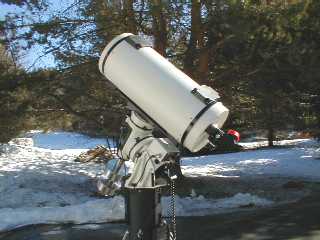 A common sight in my driveway during
March and April of 2001: The scope greeting
the morning after a long nights' use.
Night after night, I found myself hoping it would be clear when I got home
so that I could use this telescope. I looked for any excuse for us to be
under the stars together. Although I used it on and off for two months,
I still felt it would perform better given steadier conditions -- a scary
thought considering how well it was already doing.
Is this the "best" telescope in its aperture range? I have no idea, since the
term means so many different things to different people. Suffice it to say,
this is the telescope I would buy if I could. Highest recommendation. A
telescope has not made me this happy in a long time.
AP 10" Mak Hots:
A common sight in my driveway during
March and April of 2001: The scope greeting
the morning after a long nights' use.
Night after night, I found myself hoping it would be clear when I got home
so that I could use this telescope. I looked for any excuse for us to be
under the stars together. Although I used it on and off for two months,
I still felt it would perform better given steadier conditions -- a scary
thought considering how well it was already doing.
Is this the "best" telescope in its aperture range? I have no idea, since the
term means so many different things to different people. Suffice it to say,
this is the telescope I would buy if I could. Highest recommendation. A
telescope has not made me this happy in a long time.
AP 10" Mak Hots:
Killer optics
Ultra-precise mechanics
Innovative cooling system
AP 10" Mak Nots:
Expensive, needs good mount
High power, narrow field of view
If you don't already know you're getting one, you're not getting one
The Verdict:
Stop presses: AP debuts killer mirror-based telescope!
2) Stellarvue 80 mm f/9 6/1/01, 7/21/01, 5/21/02
(80 mm f/9 achromat, equatorial mount, 25/15 mm Plossls, 1X finder)
($369 OTA, $539 w/ mount, new units are f/9.4)
Another good value from Stellarvue. Vic Maris uses lenses of his own
proprietary design, hand-selects the best samples, and spends time matching
the lenses collimating the tubes. The end result is that Stellarvues cost
a little more, but you are virtually guraranteed a good sample. Judging from
the mail I get, Stellarvue's products and its customer service seem to be
above average.
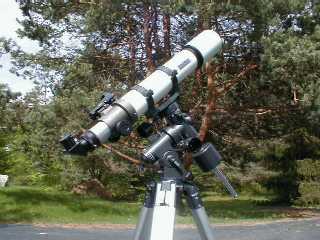 The 80 mm f/9 Stellarvue
In a move which is probably not fair to either Stellarvue or Vic Maris, I
immediately measured to exit pupil of the scope and can report that
this f/9 sample is operating at its full aperture (Click Here if you don't
understand this reference.) The optics are very good, only slightly
undercorrected, with about the level of false color you'd expect from
an 80 mm f/9 achromat. There's a very light ring of purple around Saturn
and a slightly brighter one around Jupiter.
I've seen this scope many times over the past few months and have always
been pleased with the views. I borrowed this sample from its owner for
about two weeks. During that time, it was a fine compliment to other scopes
that I had on hand. On one evening, I was curious if I could see all the M
objects in the Virgo Cluster from my driveway. Before I knew it, three hours
had gone by and I had logged dozens of objects. When you lose track of time,
that's generally a sign of a good scope.
By the way, all of the M Virgo galaxies were visible, although the dimmer ones
like M91 were a little tough (I needed averted vision.) While a larger telescope
like a 6" or 8" reflector will allow you to identify and study these smaller,
dimmer deep sky objects, on a smaller scope like this one the most you can
hope for is identification. Still, this isn't bad, and with persistance and skill
you could get through a Messier Marathon with a small scope like this Stellarvue.
The mount is your standard-issue unit from the Far East that's commonly known
as the Orion Sky View Deluxe but is known by several other names as well. It's
a decent mount for casual observing, but not really suitable long-term astro-
photography. The eyepieces are generic Far East Plossls. While serviceable,
you might want to think about upgrading them when you get the cash. I liked
the large Red Dot finder, a kind of large-window version of TeleVue's Quik Point.
Also, the focuser is a 2" unit, a nice luxury at this price level.
Newer versions are f/9.4. Recommended for small achromat buyers willing to pay
a little more for some extra attention.
Update, 7/01: Stellarvue reports that new versions of this f/9 refractor
use proprietary lenses of Maris' own design, which are said to be better than
the conventional BK-7 glass used by similarly-priced small refractors. These
newer versions use optics sourced from many suppliers.
End Telescope Reviews, Page 16
The 80 mm f/9 Stellarvue
In a move which is probably not fair to either Stellarvue or Vic Maris, I
immediately measured to exit pupil of the scope and can report that
this f/9 sample is operating at its full aperture (Click Here if you don't
understand this reference.) The optics are very good, only slightly
undercorrected, with about the level of false color you'd expect from
an 80 mm f/9 achromat. There's a very light ring of purple around Saturn
and a slightly brighter one around Jupiter.
I've seen this scope many times over the past few months and have always
been pleased with the views. I borrowed this sample from its owner for
about two weeks. During that time, it was a fine compliment to other scopes
that I had on hand. On one evening, I was curious if I could see all the M
objects in the Virgo Cluster from my driveway. Before I knew it, three hours
had gone by and I had logged dozens of objects. When you lose track of time,
that's generally a sign of a good scope.
By the way, all of the M Virgo galaxies were visible, although the dimmer ones
like M91 were a little tough (I needed averted vision.) While a larger telescope
like a 6" or 8" reflector will allow you to identify and study these smaller,
dimmer deep sky objects, on a smaller scope like this one the most you can
hope for is identification. Still, this isn't bad, and with persistance and skill
you could get through a Messier Marathon with a small scope like this Stellarvue.
The mount is your standard-issue unit from the Far East that's commonly known
as the Orion Sky View Deluxe but is known by several other names as well. It's
a decent mount for casual observing, but not really suitable long-term astro-
photography. The eyepieces are generic Far East Plossls. While serviceable,
you might want to think about upgrading them when you get the cash. I liked
the large Red Dot finder, a kind of large-window version of TeleVue's Quik Point.
Also, the focuser is a 2" unit, a nice luxury at this price level.
Newer versions are f/9.4. Recommended for small achromat buyers willing to pay
a little more for some extra attention.
Update, 7/01: Stellarvue reports that new versions of this f/9 refractor
use proprietary lenses of Maris' own design, which are said to be better than
the conventional BK-7 glass used by similarly-priced small refractors. These
newer versions use optics sourced from many suppliers.
End Telescope Reviews, Page 16
Back to Home Page
 The Big Mak in Action
(Mount: AP900)
The Big Mak in Action
(Mount: AP900) The 10" prototype seen at
Astrofest, 1999
The 10" prototype seen at
Astrofest, 1999 The scope in its case
The scope in its case The flash went off in this photo. Note
the complete absence of reflections
off the meniscus lens.
The flash went off in this photo. Note
the complete absence of reflections
off the meniscus lens. Cool, huh? The Mak with its back
removed. Focuser is at lower right.
Cool, huh? The Mak with its back
removed. Focuser is at lower right. Looking into the visual back with
the cover removed. Power switch
and plug for fans are at 10 o'clock.
Perforated holes mark locations
of the cooling fans.
Looking into the visual back with
the cover removed. Power switch
and plug for fans are at 10 o'clock.
Perforated holes mark locations
of the cooling fans. A common sight in my driveway during
March and April of 2001: The scope greeting
the morning after a long nights' use.
A common sight in my driveway during
March and April of 2001: The scope greeting
the morning after a long nights' use. The 80 mm f/9 Stellarvue
The 80 mm f/9 Stellarvue